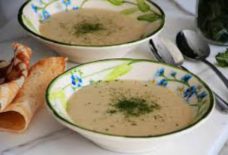A Brief Encore for Little Syria: Sights, Sounds and Even Smells
Little Syria hasn’t been so Syrian in a long while.
Torn apart by the construction of the Brooklyn-Battery Tunnel in the 1940s and then left for dead by the building of the World Trade Center a quarter-century later, the once-thriving Syrian quarter of Lower Manhattan is now disappearing from living memory, too. That is why a new exhibition, “Little Syria, N.Y.: An Immigrant Community’s Life and Legacy,” is such a welcome, though temporary, addition to the old neighborhood.
With modest resources but an important idea — that Arab-Americans were once a vibrant presence downtown — “Little Syria” evokes the period from the 1880s to the 1940s. The exhibition includes photographs and phonograph records, clothing and textiles, newspaper articles, books, correspondence, a halvah tin and a coffee grinder. On display is a 1916 letter from the poet Kahlil Gibran, on the stationery of the Syrian-Mount Lebanon Relief Committee, 55 Broadway, asking for support in the cause of aiding victims of a three-year famine. “The Sacred,” a documentary about the community by Ozge Dogan, plays continuously. (You can also watch it on Vimeo.)
There is a poignant paradox to interest in Little Syria growing at a time when the Syrian state itself is imperiled.
At the exhibition, which runs through May 27, there are also recordings that visitors can sample (Salim Doumani covering “Mata Ya Kiram El Hay,” for example) and boxes with air holes punched in the top through which visitors can savor the aroma of cardamom-flavored coffee and a distinctive spice known as za’atar — sumac, thyme, sesame seeds and salt.
The exhibition is the work of the Arab American National Museum of Dearborn, Mich. Its founding director, Anan Ameri, said she developed the idea while researching Lower Manhattan in 2010, during the national controversy over a proposal to build a Muslim community center and mosque not far from the World Trade Center.
“To my surprise,” she said, “I found out that this neighborhood had been historically an Arab neighborhood.”
Elizabeth Barrett-Sullivan was the curator of the show. Matthew Stiffler was the researcher. The exhibition design was by the Good Design Group. The Ford Foundation is among the sponsors. Dr. Ameri said it cost about $175,000 to research, curate, design, install and house the show, in Studio B of the 3LD Art and Technology Center, 80 Greenwich Street, at the base of the Battery Parking Garage building.
“What we found amazing was that the space was in the heart of where Little Syria was,” Dr. Ameri said. The Battery Parking Garage occupies much of the block south of Rector Street. Among the buildings it replaced was 77 Washington Street, the home of the A. J. Macksoud music company and the Son of the Sheik restaurant.
Most of the immigrants from Syria, Lebanon and Palestine who settled in Lower Manhattan were Christian. The former St. George’s Syrian Catholic Church at 103 Washington Street, an official city landmark (designation report as a PDF), is the most obvious remaining vestige of Little Syria. Next to it are the former Downtown Community House, Nos. 105-107, and a tenement at No. 109 that typifies the old housing stock in the area. Advocates imagine this three-building cluster, between Rector and Carlisle Streets, as a historic district. The Landmarks Preservation Commission is not persuaded.
But it is one of the satisfactions of the show that one can finish looking at display cases full of artifacts of Syrian-American life and then walk 200 yards to see the background against which those lives were led long ago.
David W. Dunlap
The New York Times Blogs


